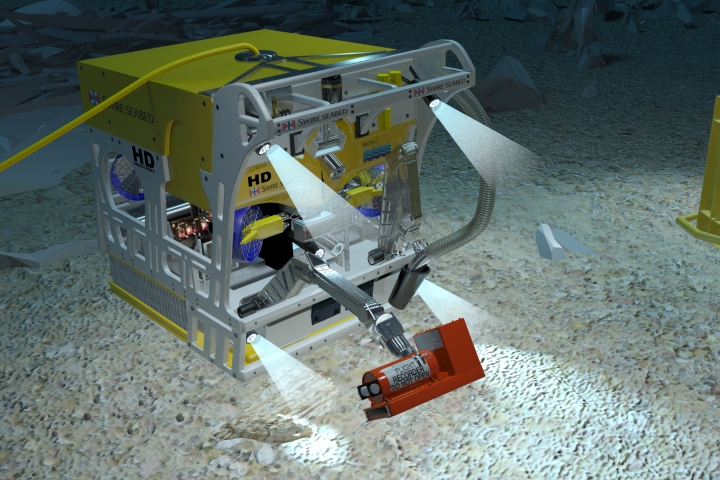
The Seabed Worker’s unique wake trailed to the east as the morning sun glowed on the NASA vehicle assembly building in the west. After more than 40 years on the bottom of the ocean, the F-1 engines were returning to NASA and back to the famous Apollo launching grounds at Cape Canaveral.
The team had set out prepared to recover three massive Apollo 11 engines near the Bermuda Triangle in water depths of over 14,000 feet or 4,300 meters. After three weeks at sea searching numerous debris fields spread over 40 square miles of ocean, the team did not find an intact engine. However, we did recover what remained of several engines, including one from Apollo 11 as well as their turbo pumps, heat exchangers and LOX injectors; enough pieces that a good representation of an engine could be lovingly restored for display in a museum.
 The ship slowly entered Port Canaveral, mooring to one of the secure piers within the port facility. After clearing customs, the crew began the process of offloading the artifacts onto waiting tractor trailers.
The ship slowly entered Port Canaveral, mooring to one of the secure piers within the port facility. After clearing customs, the crew began the process of offloading the artifacts onto waiting tractor trailers.
Each piece was carefully hoisted on shore by the ship’s 50-ton deck crane. Members of the restoration team worked feverishly to stabilize each artifact.
Every item was wet down and covered in wet cotton batting. The batting was then covered with shrink wrap to keep the items wet until they reached their final destination at the Cosmosphere in Kansas.
 Three tractor trailers loaded with artifacts left Cape Canaveral. Meanwhile, the ship headed back to Bermuda to load gear left in Bermuda. The trucks rolled westward, departing Cape Canaveral and arriving at the Cosmosphere just outside Wichita, Kansas two days later.
Three tractor trailers loaded with artifacts left Cape Canaveral. Meanwhile, the ship headed back to Bermuda to load gear left in Bermuda. The trucks rolled westward, departing Cape Canaveral and arriving at the Cosmosphere just outside Wichita, Kansas two days later.
Why Wichita? The city has been known as the Air Capital of the World since the early part of the last century. The most famous aircraft pioneers started their manufacturing here such as Cessna, Mooney and Beechcraft. Later, Boeing, Bombardier and Raytheon all joined the ranks of the manufacturers located in this aviation hub.
 The long restoration and conservation process is being handled by The Kansas Cosmosphere & Space Center which is home to the largest collection of rocket and space items outside the Smithsonian Air & Space Museum. This gorgeous repository of space items is one of the few facilities certified by the Air & Space Museum to restore artifacts prior to their display.
The long restoration and conservation process is being handled by The Kansas Cosmosphere & Space Center which is home to the largest collection of rocket and space items outside the Smithsonian Air & Space Museum. This gorgeous repository of space items is one of the few facilities certified by the Air & Space Museum to restore artifacts prior to their display.
Now the remains of the famous Apollo missions joined the Cosmosphere for restoration in the newly-created laboratory inside their facility. Most important to the restoration is public involvement, which is why the new venue has a public viewing area.
The entire conservation process will require over two years of painstaking work, all within easy reach of the general public. Each artifact is rinsed to remove any trace of salt and cleaned, then flushed with corrosion-preventing solutions. Next is photographing and documenting each piece prior to disassembly. The dismantling of artifacts is no easy feat as these engines are surprisingly complex, with hundreds of parts that have to be carefully and meticulously separated. After disassembly, every artifact is further cleaned, restored and reassembled prior to display.

The F-1 engine is still the most powerful single-nozzle, liquid-fueled rocket engine ever flown and represents amazing leaps forward in engineering during the 1960s. These icons of man’s lunar achievement stand as an inspiration to future generations.
Now it’s your turn. Visit the Cosmosphere in Kansas while these icons of exploration are being restored. Go to the Museum of Flight in Seattle and be inspired. Walk through the new Air & Space Museum at the Dulles airport and reach for the stars.
© Copyright 2014 Vincent Capone
With Permission from Bezos Expeditions
Missed earlier posts in this series?
The story begins here: How Do you Recover An Apollo Rocket Engine from 3 Miles Beneath the Bermuda Triangle?
The search gets underway here: Finding An Apollo Rocket Engine in the Deep Ocean
The best recovery ship for the job is found here: The Right Stuff for a Deepwater Recovery
Marvel at the recovery technology in action here: Operations of the F-1 Engine Recovery
The moment of truth. F-1 engine artifacts come aboard: The Apollo F-1 Engine Recovery


